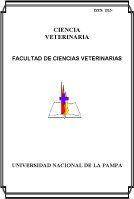Leucosis Enzoótica Bovina: estudio seroepidemiológico en rebaños de cría de la provincia de La Pampa, Argentina
Abstract
Bovine leukosis virus (BLV) infection is pandemic in cattle and there are many seroprevalence studies in dairy herds, but not in beef cattle. A National Program of Control and Eradication of bovine leukosis is ready to start in Argentina, therefore it is necessary to know what is the prevalence of infection and what are the risk factors associated with the management and production systems. The presence of the bovine leukosis was analyzed in 1798 serum samples from 30 beef herds, in the Mará-Có department of La Pampa-Argentina. The samples were tested for the presence of BLV antibodies by agar-gel immunodifussion, and the samples coming from the herds, where there was at least on positive cow, were all retested by ELISA. In order to evaluate BLV transmission risk factors associated to local conditions of management and production systems, a questionnaire including aspects on herd's size, breeding, alimentary and sanitary status was carried out in each farm. In 3 of the 30 herds studied, there was one positive cow in each one of them. This means 10% of heard prevalence and 0.17% poblacional prevalence. The positive herds belong to the small ones sampled, with particular characteristics that could become in risk factors of the disease. This work could be a precedent to carry out assays of this kind in other regions of La Pampa and to other provinces of the country, making a special emphasis on the evaluation of small herdsDownloads
Downloads
Published
How to Cite
Issue
Section
License
Al momento de enviar sus contribuciones, los colaboradores deberán declarar , de manera fehaciente, que poseen el permiso del archivo o repositorio donde se obtuvieron los documentos que se anexan al trabajo, cualquiera sea su formato (manuscritos inéditos, imágenes, archivos audiovisuales, etc.), permiso que los autoriza a publicarlos y reproducirlos, liberando a la revista y sus editores de toda responsabilidad o reclamo de terceros , los autores deben adherir a la licencia Creative Commons denominada “Atribución - No Comercial CC BY-NC-SA”, mediante la cual el autor permite copiar, reproducir, distribuir, comunicar públicamente la obra y generar obras derivadas, siempre y cuando se cite y reconozca al autor original. No se permite, sin embargo, utilizar la obra con fines comerciales.



4.png)


7.png)



